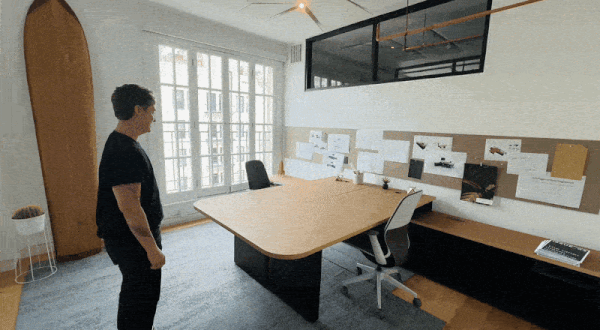Rethinking the Meeting Room: How Static Spaces Hold Back Productivity

Walk through any modern office, and you’ll spot the irony right away: glass-walled conference rooms standing empty while employees hunt for a quiet place to work.
Traditional office floor plans have long given meeting rooms a place of prominence. Tucked behind glass walls or anchored in central corridors, these spaces are supposed to signal collaboration, status, and purpose.
However, despite their prime locations, meeting rooms are remarkably underused. According to research from Density.io, meeting rooms sit empty roughly 70% of the time. Even when occupied, nearly 60% of their seats remain vacant.
This mismatch between design intent and actual usage has become harder to ignore as companies look more closely at how every square foot supports work.
In this article, we’ll explore why meeting rooms so often fall short, how adaptable design can help spaces pull double duty, and why a more flexible approach to office layouts is gaining momentum.
The Meeting Room Paradox
Many organizations track conference room bookings and see packed schedules as proof of engagement. The reality is more complicated.
Employees frequently reserve large rooms for small group discussions or solo focus time simply because there are few alternatives. Others roam the office, searching for a quiet corner to concentrate, even as empty chairs sit behind frosted glass.
This creates a hidden strain: valuable space that costs companies dearly per square foot ends up serving fewer people, less often, than intended. Over time, such a mismatch adds up to wasted resources, frustrated teams, and a persistent gap between what the office provides and what people actually need.
At the same time, the need for private, distraction-free environments has never been clearer. As hybrid schedules and task variety become the norm, employees expect spaces that can flex between collaboration and deep focus. A static room reserved weeks in advance rarely meets those demands.
Architectural Agility: Space That Adapts in Real Time
Digital tools have given workers flexibility to collaborate from anywhere. Unfortunately, the physical environment has lagged behind.
Walls and fixed tables remain static, even as the nature of work changes hour by hour. A room set up for a ten-person meeting at 9 a.m. may sit unused all afternoon while employees need private spaces for calls, focused work, or small team huddles.
The rigidity of these setups limits how well the office can respond to shifting demands, leaving valuable square footage locked into a single function that rarely matches the pace or variety of modern workflows.
As a result, more companies are now exploring solutions that allow a single space to serve multiple functions over the course of a day. Movable partitions, modular furnishings, and reconfigurable elements can help a meeting room shift from a ten-person gathering to several focused workstations in a matter of minutes.
One recent example of this thinking in action comes from Studio Other’s own office. Tasked with transforming a conventional meeting room into a multi-functional environment, the team developed a custom-engineered table system that easily glides apart for individual workstations or locks together as a communal conference surface.
By borrowing a sliding rail mechanism more common to industrial equipment, they demonstrated how thoughtful engineering can allow a single space to shift between collaboration and focus in moments, illustrating the power of adaptable design to make every square foot more useful.
This kind of adaptability helps meet the demand for heads-down space and the continued requirement for shared meeting areas—without requiring costly build-outs or relocation.
The ROI of Focus at Work
Open-plan offices were once celebrated as catalysts for collaboration, hailed as a way to break down silos and spark spontaneous ideas across departments. The absence of walls was supposed to encourage transparency, faster communication, and a stronger sense of shared purpose.
However, research consistently shows that excessive noise and interruptions chip away at productivity and satisfaction. A Harvard Business Review report found that even brief distractions can double the rate of errors and increase stress.
Companies that invest in settings where employees can retreat and think without disruption often see measurable benefits. These include shorter project timelines, improved work quality, and higher retention among people who feel their needs are respected.
Companies that create quiet, reservable spaces for focus work often see improvements in output, engagement, and retention. When people can count on having somewhere to think without interruption, it supports both individual performance and team effectiveness.
Let’s Embrace a Different Approach to Space Planning
Workplace design is entering a new chapter. Rather than devoting entire rooms to a single purpose, more companies are embracing layouts that shift in step with the demands of the day.
This mindset doesn’t just stretch the value of expensive square footage—it also shows employees that their need for both connection and quiet is taken seriously.
Rethinking the meeting room starts with challenging long-held assumptions. If a space is rarely full or leaves people vying for privacy, it may be time to look past static walls and fixed tables. Spaces that can transform in minutes bridge the gap between group collaboration and focused work, making the office a more responsive place for everyone.